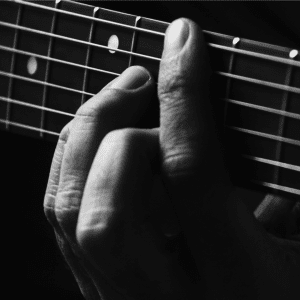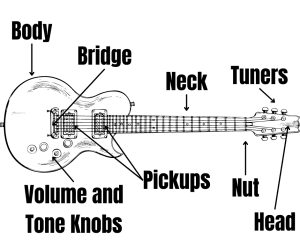All The Guitar Lingo, Slang, And More
Whether you’re new or old to the guitar, there’s a lot of lingo, sland and vocabulary to know. Perhaps you’ve been reading articles on how to play guitar and something came up that you don’t understand. Maybe you’ve even read a few of my guitar basics articles and we didn’t define what something meant.
Well, here’s our list of guitar lingo and vocabulary. I don’t intend for this list to ever be finished. I’ll update it as more come to mind.
Action refers to how high the strings are above the fretboard. Generally speaking a lower action is a good thing (although some players and styles prefer a higher action). A higher action means you have to push further and harder to fret a string, making it more difficult to play the guitar.
Getting a professional set up on your guitar can often get you a lower action through adjusting the bridge, nut, and neck curvature.


You’ll see the technique written as both “barre” and “bar.” The term comes from the French “barré” which means barred.
A bend is just like it sounds like. It involves bending a string so that it makes a higher pitch. Typically (but not always), you play the note then bend it. However, you can do reverse bends as well.
A chord progression is simply a collection of chords in a certain order, usually repeated to play a song. You may see a chord progression written a letters, for example E, A, E, B, A. You may also see a chord progression as numbers or Roman Numerals, for example I, IV, I, V, IV.
When referring to a chord progression in terms of numbers, you’re referring to the degree of the scale. This is handy when talking to other musicians or trying to transpose a song into a different key.
Take a look at some of the easy guitar songs we have listed. Often you’ll see the chords listed above the lyrics. This both forms the progression and helps you know when to change chords.
A hammer on is performed by picking a note then using your fretting hand to slam a finger down (hard) on a fret higher up the neck. This should make a note sound without having to pick it.
A humbucker is a type of pickup that is essentially two single coil pickups with opposite polarity. This set up reduces the typical hum you get from single coil pickups (hence the name humbucker).
While humbuckers are great for noise reduction, they tend to be less bright than single coils.
An interval is the difference between two notes. You’ll often hear someone refer to an “octave,” a “3rd”, a “7th,”, these are all intervals.
Finding intervals on guitar is an important skill to have for improvisation and general musicality.
Intonation refers to how well a guitar is in tune across the fret board. Basically if the guitar is “in tune with itself.” As an example, if you play a note on the 12th fret, this should be exactly an octave above the open string.
Guitars are ultimately imperfect instruments, so the note you’re fretting won’t always be exactly what it should be; it may be off very minimally. The close it is to perfect the better. And that’s good intonation.
A lick is a small collection of notes usually used in a solo or as a filler line. If it’s a longer solo, the player may use a few different licks to create the solo, along with other notes. You can make up your own licks, but there are also a lot of licks out there that are swapped between guitar players.
You’ll see licks appear in other instruments as well. It’s not just a guitar thing.
An open chord is one played in open position. These are usually one of the five basic chords shapes (plus the minors). Open position is just the position at the very end of the guitar neck where the nut acts as the “zero” fret.
Open chords are called open chords, not only because they’re in open position, but because they have open strings played as part of the chord.
Open tuning is a type of non-standard tuning where the guitar is tuned to be an open chord. This means that rather than the standard EADGBE, the guitar is tuned to be, for example, a G chord or a D chord. There are advantages to open tunings depending on the style of music being played and techniques being used.
A palm mute reduces the sound and the sustain on notes/chords played by resting the side of the palm of the strumming hand on the bridge of the guitar. It shouldn’t damped the sound completely, just give it a bit of a “thunking” sound.


A pentatonic scale is a scale made up of five notes. Your “standard” is made up of seven notes, but a pentatonic scale is a handy shortened version that is a great basis for improvising.
While there are different kinds of pentatonic scales out there but the most common are the minor pentatonic scale and the major pentatonic scale.
A power chord is a chord made up of a root note and a 5th (and usually an octave). Power chords are great for Rock music and have a thicker sound than just playing a single note, but obviously aren’t as full as a complete chord.
A pull off is when you fret two notes on the same string with two different fingers. Pluck the note then release the higher fretted note quickly and a little bit of force. This allows the note on the fret behind to sound.
A riff is a pattern of notes and/or chords that is usually repeated for the entirety (or part of) a song. Think about songs like Smoke On The Water by Deep Purple or Day Tripper by The Beatles. These are both riff based songs.
Riffs are popular in rock and pop music and aren’t exclusive to guitar. If you’re new to guitar, you’ll likely start with a few chords and a few riffs.
A type of electric guitar pickup common on Stratocasters and many other types of guitar.
Single coil pickups are called single coil because they use a single electric coil to create the magnetic field that converts string vibration into an electrical signal.
While single coil pickups have a great clear sound, they are also known for “single coil hum” and can pick up unwanted noise.
A slash chord is a chord that is written as “chord name”/bass note. For example a C/G would indicate that you should play a C chord with with a G as the bass note rather than a C. These chords can be great to make things easier to play, add interest to a song, or as a passing note or chord to add some flavour.
Standard tuning refers to the “normal” tuning for a guitar. This tuning is (from low to high) EADGBE. This tuning is in 4ths, except for the interval between the G and B strings which is a major 3rd. This may sound weird, but there’s a reason why the guitar is tuned that way.
Standard tuning isn’t the only kind of guitar tuning out there. Other common tunings include open tuning, where the guitar is tuned to a chord, and drop D tuning, where the low E string is tuned down to a D. This tunings have their advantages and disadvantages.
A 7th chord is a chord with the standard 1, 3, 5 triad with the addition of the 7th degree of the scale. This 7th can be major, minor, or diminished. Most of the time, if someone just says “7th chord” they’re talking about dominant 7th chords (a major chord with a flattened 7th). Dominant 7th chords occur a lot in popular music.
A solid state amp is an amplifier that uses transistors to amplify a sound.
There are two main styles of amplifier: solid state and tube (sometimes called valve) amps. Learn the difference between solid state and tube amps.
As the name would suggest, this is the standard/normal way to tune a guitar. From low to high this tuning is EADGBE. This tuning is all perfect 4ths except for the interval between the G and B, which is a 3rd.
Here I explain why the guitar is tuned like that. There are other tunings out there, but you’ll mostly encounter standard tuning.
Guitar strings are often referred to by their numbers. Although in standard tuning the strings are tuned (from low to high) E, A, D, G, B, E, there are other tunings out there. Either way, it’s often more convenient to use string numbers with 1 being the highest string and 6 being the lowest string. In a lot of the guitar lessons on this website I’ll refer to strings by their number.
Guitar tablature (or tab) is a type of notation for guitar. Ultimately, guitar tabs are easier to read than sheet music.
If you’re unsure how to read tabs, here’s an article on how to read guitar tabs.
Sometimes also called valve amps, a tube amp is one that uses vacuum tubes to amplify sound. This technology is older than solid state amps but often produces a warmer tone.
Here’s a full article on the difference between tube and solid state amps.
A valve amp is another name for a tube amp.
